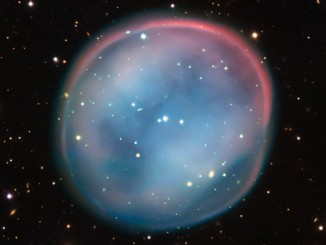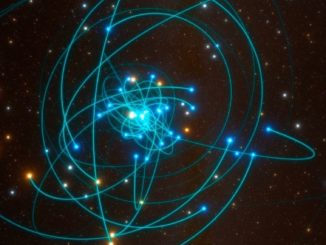
Astronomers have for the first time captured what appears to be the moment when a red giant star evolves into a stunning butterfly-like planetary nebula. Using the SPHERE instrument on the European Southern Observatory’s Very Large Telescope (VLT), researchers have generated some of the sharpest images ever made of L2 Puppis, to reveal an emerging planetary nebula, born when an ageing red giant sheds its cool outer layers in a series of mass-loss events.
This transformation of star in the later stages of its life occurs over a relatively short period of time (astronomically speaking), so how were these amazing images captured? “The extreme adaptive optics of SPHERE on the VLT, when used in the optical as we did with the instrument ZIMPOL, lead to the sharpest images ever. We can thus see details that were never seen before,” explains Eric Lagadec, from Observatoire de la Côte d’Azur, France and one of the team members who imaged this emerging planetary nebula.
L2 Puppis is metamorphosing into what looks like a typical bi-polar nebula, whereby the dust surrounding the star is being arranged in a disc that flares outwards, creating a symmetrical, funnel-like shape. Stellar winds produced by the star in the late stages of its life, channel the expelled material into a myriad of shapes we have become accustomed to seeing (such as the Helix Nebula or the Cat’s Eye Nebula). Other processes are also thought to contribute to this process, but to what extent these mechanisms have on shaping the planetary nebula is still not fully understood, perhaps until now.
One of the leading theories as to how bipolar planetary nebulae are produced relies on the existence of a binary star system. This theory fits well with the teams results as during their observations an additional source of light was discovered. The source has been identified as a companion star, likely to be another red giant of slightly lower mass, but less evolved and about 300 million kilometres – twice the distance from Earth to the Sun – from L2 Puppis. “It is a clear confirmation that binaries can lead to the formation of bipolar nebulae. This had been shown by indirect methods for planetary nebulae, but here we see it directly, and in the phase before (the AGB phase). For the first time we directly imaged two stars, with a disc in the orbital plane, and material being ejected in a direction perpendicular to that disc. This is a spectacular confirmation of bipolar planetary nebulae shaping models” says Lagadec.
Nonetheless, this is just one example of a blossoming planetary nebula seen with a companion star – are all bipolar nebulae produced by binary stars? “I do think it is the case. Other processes such as magnetic fields can shape nebulae, but the angular momentum needed to sustain such a magnetic field requires the presence of a companion” says Lagadec.
It seems this theory is favoured with other researchers too, albeit it is not necessarily a companion star that is required. “Not all bipolar planetary nebula are the result of binaries, the star [transforming into a planetary nebula] only needs a hot Jupiter around it to create the torus (disc) structures that we observe,” explains Liz Guzman, an ESO astronomer who specialises in planetary nebulae. “It has to be said though, that it is difficult to explain bipolar planetary nebula with a single star.”
With images such as these, it is likely that more emerging planetary nebula will be detected in the near future, giving astronomers a clearer picture on how important binary stars are for producing bipolar planetary nebula.



